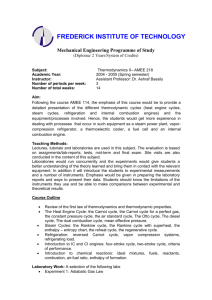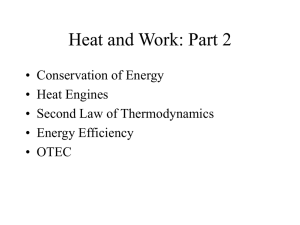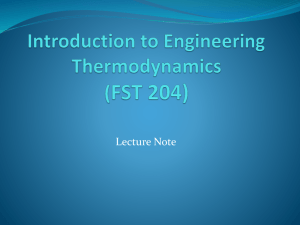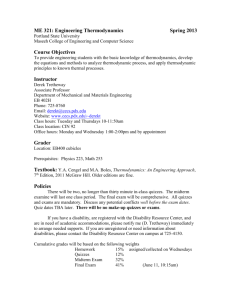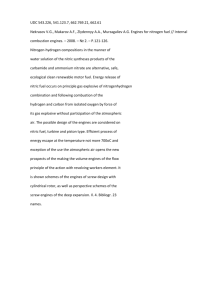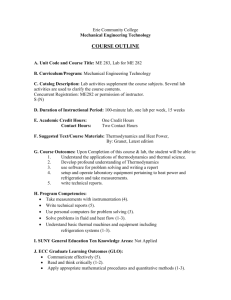EM317 Thermal-Fluid Sciences II United States Naval Academy
advertisement
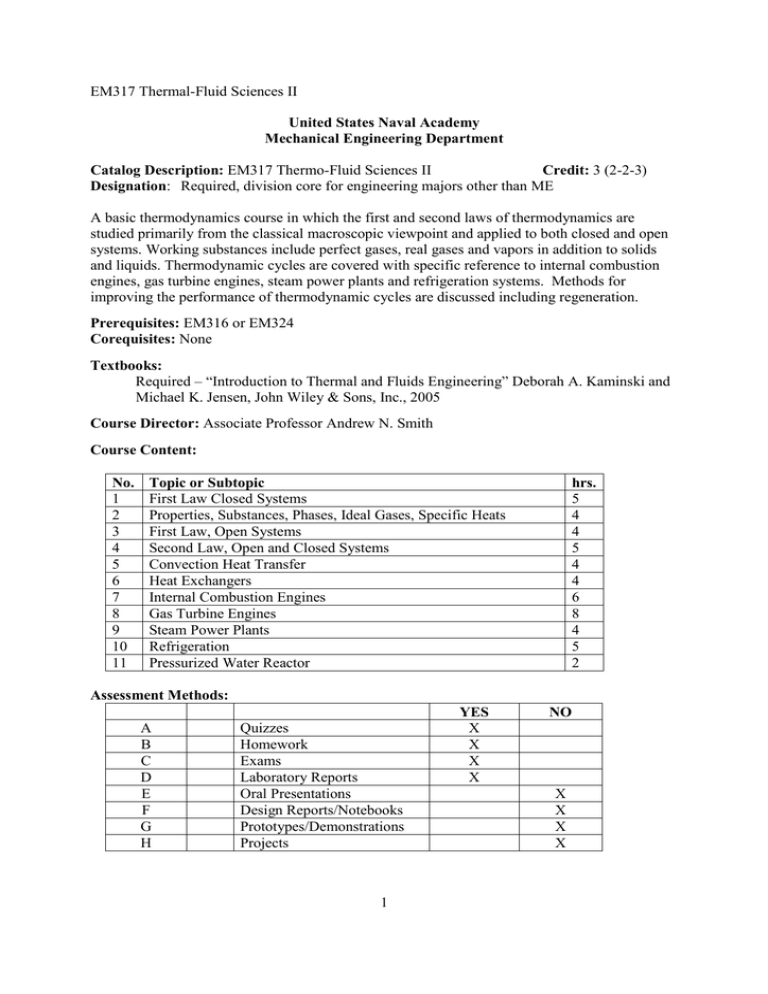
EM317 Thermal-Fluid Sciences II United States Naval Academy Mechanical Engineering Department Catalog Description: EM317 Thermo-Fluid Sciences II Credit: 3 (2-2-3) Designation: Required, division core for engineering majors other than ME A basic thermodynamics course in which the first and second laws of thermodynamics are studied primarily from the classical macroscopic viewpoint and applied to both closed and open systems. Working substances include perfect gases, real gases and vapors in addition to solids and liquids. Thermodynamic cycles are covered with specific reference to internal combustion engines, gas turbine engines, steam power plants and refrigeration systems. Methods for improving the performance of thermodynamic cycles are discussed including regeneration. Prerequisites: EM316 or EM324 Corequisites: None Textbooks: Required – “Introduction to Thermal and Fluids Engineering” Deborah A. Kaminski and Michael K. Jensen, John Wiley & Sons, Inc., 2005 Course Director: Associate Professor Andrew N. Smith Course Content: No. 1 2 3 4 5 6 7 8 9 10 11 Topic or Subtopic First Law Closed Systems Properties, Substances, Phases, Ideal Gases, Specific Heats First Law, Open Systems Second Law, Open and Closed Systems Convection Heat Transfer Heat Exchangers Internal Combustion Engines Gas Turbine Engines Steam Power Plants Refrigeration Pressurized Water Reactor hrs. 5 4 4 5 4 4 6 8 4 5 2 Assessment Methods: A B C D E F G H Quizzes Homework Exams Laboratory Reports Oral Presentations Design Reports/Notebooks Prototypes/Demonstrations Projects 1 YES X X X X NO X X X X EM317 Thermal-Fluid Sciences II Course Outcomes1 Students can effectively; 1. Apply conservation of mass and the 1st law of thermodynamics to the analysis of closed system including the determination of boundary work (A,B,C). 2. Apply conservation of mass and the 1st law of thermodynamics to the analysis of open systems including nozzles, diffusers, pumps, turbines, compressors, throttling valve, mixing chambers and heat exchangers (A,B,C). 3. Determine thermodynamic property information for ideal gases, water and R134a utilizing property tables, property diagrams, ideal gas law and the assumption of constant specific heats (A,B,C). 4. Apply the effectiveness NTU method to the analysis of heat exchangers (A,B,C,D). 5. Understand the 2nd law of thermodynamics and how it relates to the performance and design of heat engines (A,B,C). 6. Incorporate isentropic efficiencies in the analysis of systems that utilize turbines, pumps, compressors and nozzles (A,B,C). 7. Analyze heat pumps and refrigeration systems using the vapor-compression refrigeration cycle (A,B,C,D). 8. Analyze steam power cycles using the Rankine cycle, including cycle modifications such as reheat and regeneration (A,B,C,D). 9. Analyze gas turbine engines using the Brayton cycle, including split shaft gas turbine and aircraft engines (A,B,C,D). 10. Analyze internal combustion engines using the Otto and Diesel Cycles (A,B,C,D). 1 Letters in parenthesis refer to the assessment methods listed in the previous section. Program Outcomes (a) (b) (c) (d) (e) (f) (g) (h) (i) (j) (k) Course Outcomes (1) (2) (3) (4) (5) (6) (7) (8) (9) (10) x x x x x x x x x x x x x x x x x x x x x x x x x x x x x x x x x x x x x x x x x x x x x x x x x Date of Latest Revision: 15 MAY 2010, Associate Professor Andrew N. Smith 2

